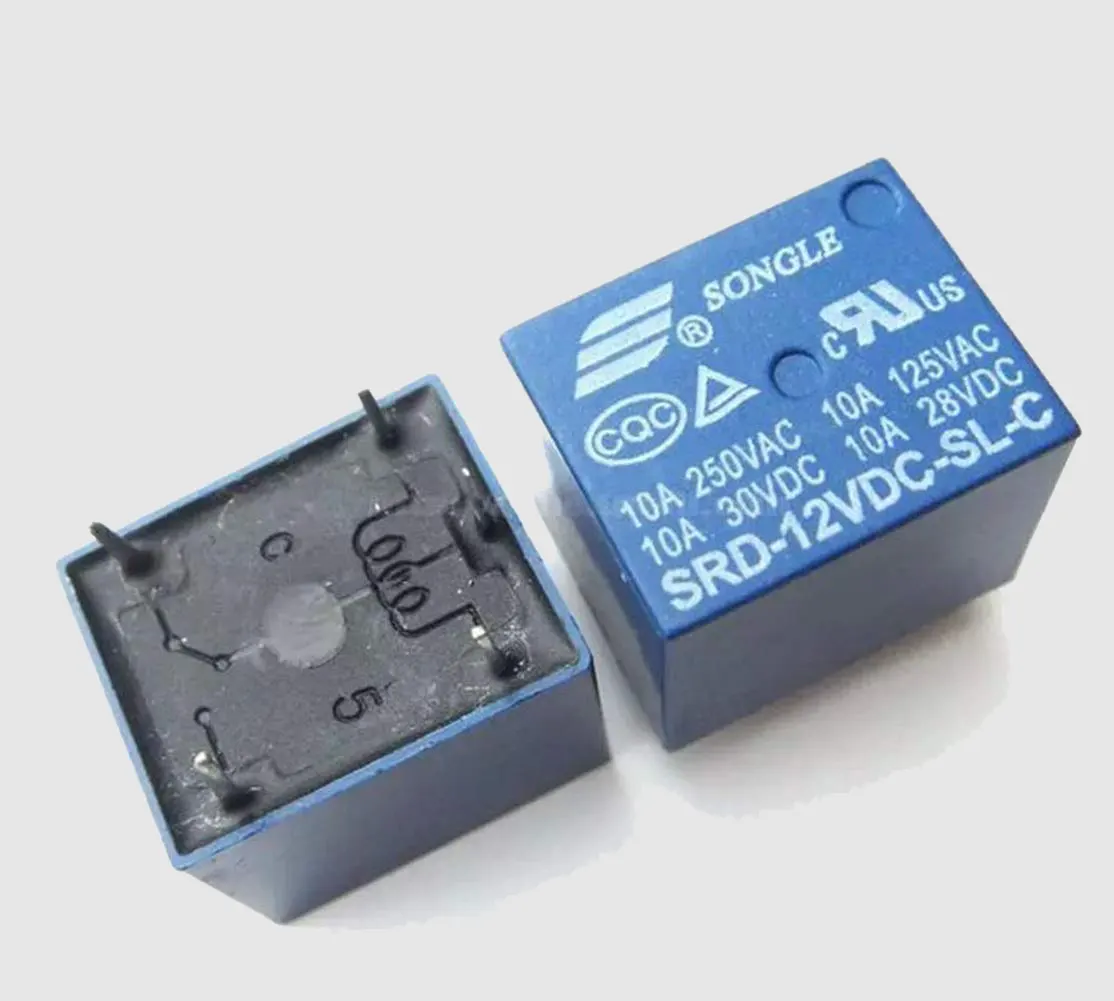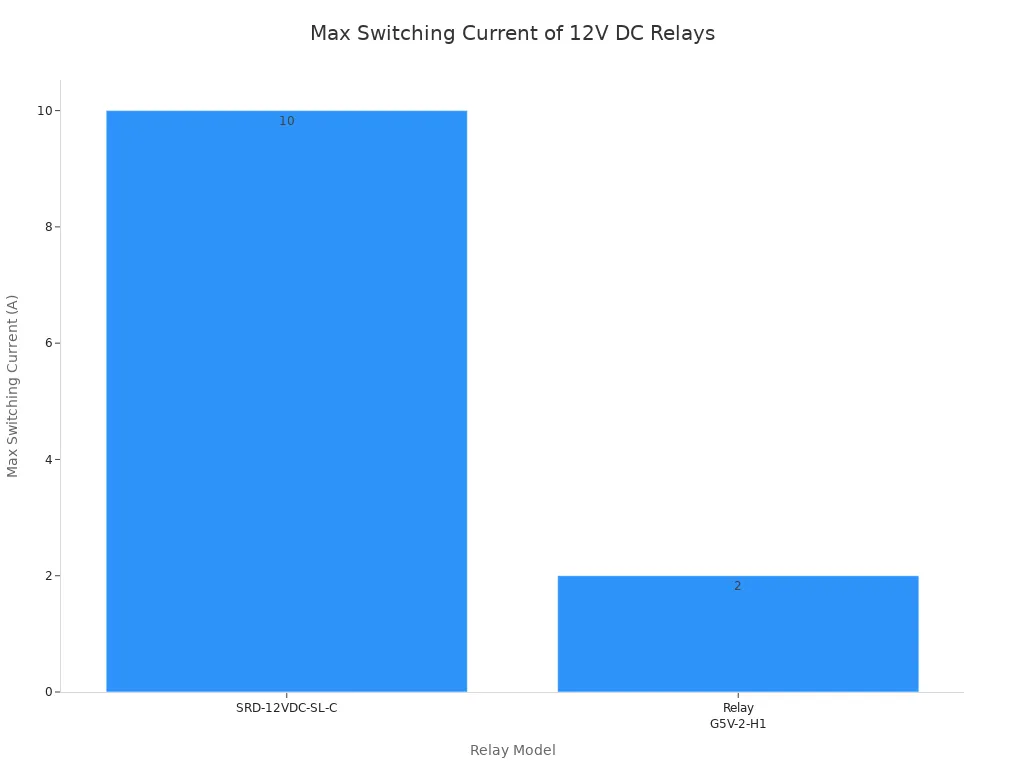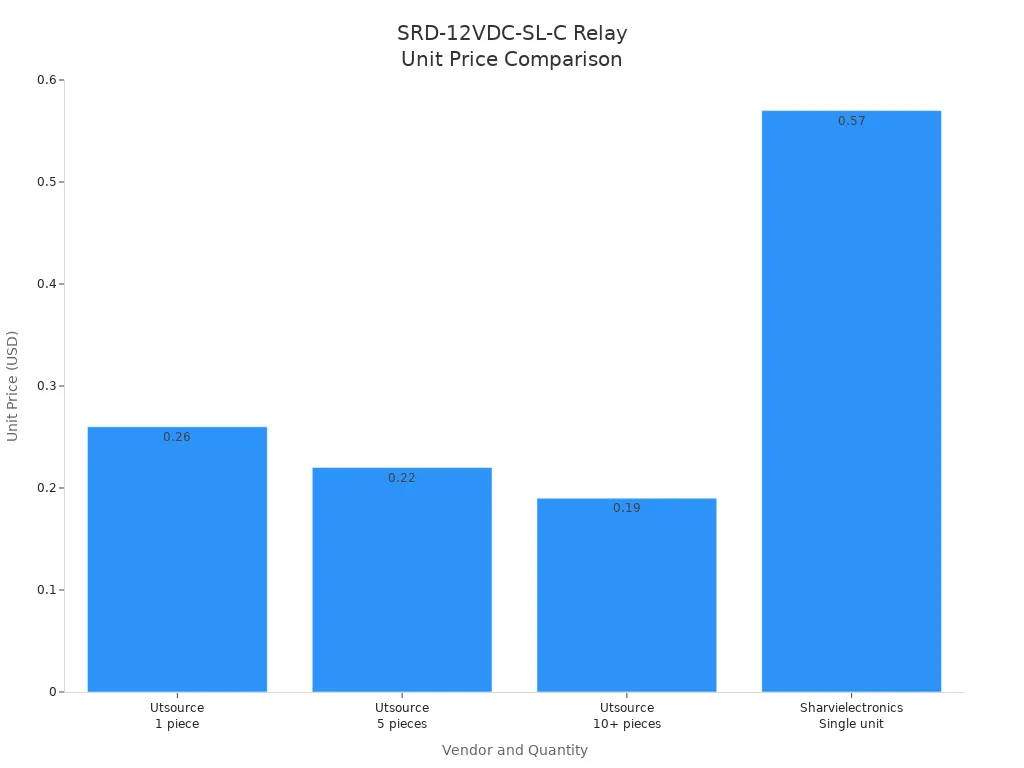
The SRD-12VDC-SL-C is a good power relay made by Ningbo Songle Relay. This relay has a 12V DC coil. It can switch up to 15A at 250V AC. It uses an SPDT (1 Form C) contact setup. The relay is small and fits through holes on a board. Engineers use this relay in many systems. Some examples are:
-
Home appliances for temperature control and smart automation
-
Industrial automation for steady signal control and device management
-
Electronic control systems for safe power use and circuit separation
| Application Area | Common Uses |
|---|---|
| Home Appliances | Runs actuators, controls temperature, and links with IoT devices |
| Industrial Automation | Changes signals, separates circuits, and keeps things working well |
| Electronic Control Systems | Gives electrical separation and small power control |
Key Takeaways
-
The SRD-12VDC-SL-C is a small and dependable relay. It uses 12V DC power. It has SPDT contacts that switch between two circuits safely.
-
This relay can handle up to 10A of current. It works with 250V AC or 30V DC. This makes it good for home appliances. It is also used in industrial automation and electronic control systems.
-
The relay is small and easy to fit on circuit boards. It uses through-hole mounting, so it does not need much space.
-
It has five pins, which makes wiring simple. This helps stop mistakes and keeps switching safe and effective.
-
Picking this relay saves money and lasts a long time. It is a good choice for many control projects. The specs are clear and it can be used in many ways.
SRD-12VDC-SL-C Relay
Overview
The SRD-12VDC-SL-C is made by Ningbo Songle Relay. It is a small and strong power relay. This relay can switch power well and does not take up much space. It uses a 12V DC coil and fits into printed circuit boards with holes. Many engineers pick this relay for projects that need safe circuit control. The SRD-12VDC-SL-C has an SPDT contact setup, also called 1 Form C. This lets the relay switch between two circuits. It is useful for many different jobs.
Note: The SRD-12VDC-SL-C relay follows RoHS rules. This means it does not have harmful materials. It is safe for new electronic designs.
Function
The SRD-12VDC-SL-C relay is an electric switch. When the 12V DC coil gets power, it makes a magnetic field. This field moves a small arm inside the relay. The arm changes the connection from one circuit to another. The SPDT (1 Form C) setup has one common terminal. It connects to either a normally open (NO) or a normally closed (NC) contact. The relay never connects both at once. When the coil turns off, a spring moves the arm back.
| Relay Type | Description |
|---|---|
| SPDT (Single-Pole Double-Throw) | Has a common terminal that connects to either Normally Open (NO) or Normally Closed (NC) contacts, but never both at the same time. Has five terminals including coil connections. Works as an electric switch to control one circuit by switching between two others. |
This 12vdc relay helps control one circuit by switching between two outputs. For example, in a home appliance, the relay can turn a heater on or off when told by a control board. In factories, relays like the SRD-12VDC-SL-C safely switch motors, lights, or other devices. The relay is built to last a long time and work well in many places.
Specifications
Electrical
The SRD-12VDC-SL-C relay works with a 12V DC coil voltage. This voltage lets the relay fit many control circuits at home or in factories. The relay can handle up to 10A of current and 12V DC of voltage. These limits make it good for things like small motors, lights, and control devices. The relay uses an SPDT contact type. This means it can switch between two different circuits.
The SRD-12VDC-SL-C relay meets RoHS rules. It does not have dangerous materials. It follows safety and environmental laws.
Here is a table that compares the SRD-12VDC-SL-C with other relays:
| Relay Model | Max Switching Current | Max Switching Voltage | Notes |
|---|---|---|---|
| SRD-12VDC-SL-C | 10A | 12V DC | Good for moderate loads and small devices |
| SRD-12VDC-SL-A | 15A | 250V AC | Handles higher current and voltage |
| Industry General Range | 10A to 30A | Up to 250V AC/DC | Standard for general-purpose relays |
Mechanical
The SRD-12VDC-SL-C relay is small and strong. Its body is about 19 mm long, 15 mm wide, and 15 mm tall. This small size helps engineers put it on crowded PCBs. The relay uses through-hole mounting. This makes it stay in place and connect well.
| Attribute | Details |
|---|---|
| Model | SRD-12VDC-SL-C |
| Pin Number | 5 |
| Dimensions (LWH) | Approximately 19 x 15 x 15 mm |
| Mounting Form | PCB |
| Coil Voltage | 12V DC |
| Contact Type | SPDT |
The relay’s plastic case keeps dust and water out. This helps the relay last longer and work in many places.
Pinout
The SRD-12VDC-SL-C relay has 5 pins. Each pin has its own job. This makes wiring and setup easy for engineers and technicians.
-
Pin 1 and Pin 2: Coil terminals (connect to 12V DC power)
-
Pin 3: Common terminal (COM)
-
Pin 4: Normally Closed (NC) contact
-
Pin 5: Normally Open (NO) contact
Tip: Always look at the relay’s datasheet for the right pin layout before wiring it.
This pin setup lets the relay switch between NO and NC contacts when the coil gets power. The clear pin layout helps stop wiring mistakes and keeps things safe.
Features
Compact Design
Engineers like parts that do not take up much space. The SRD-12VDC-SL-C is small and fits well on boards. It is about 19 mm long, 15 mm wide, and 15 mm tall. This small size lets designers put many relays on one board. There is no crowding. The through-hole mounting keeps the relay in place. It also makes sure the relay connects well. Many new devices need small parts. This relay is a good choice for that.
Tip: Small relays help make control panels and devices lighter and smaller.
Switching Capacity
The SRD-12VDC-SL-C can switch strong power loads. It handles up to 10A at 250V AC or 30V DC. This means it can control motors, lights, and other things at home or in factories. It has a higher current rating than some other 12V DC relays. For example, the G5V-2-H1 relay only works with 2A at 125V AC. The table below shows how the SRD-12VDC-SL-C compares to other relays:
| Relay Model | Coil Voltage | Max Switching Current | Max Switching Voltage | Notes |
|---|---|---|---|---|
| SRD-12VDC-SL-C | 12V DC | 10A | 250V AC / 30V DC | Higher current capacity in 12V DC category; SPDT type; robust choice |
| Relay G5V-2-H1 | 12V DC | 2A | 125V AC | Lower current rating compared to SRD-12VDC-SL-C |
| Relay Meishuo MPY-S-112-A | 24V DC | 10A | 250V AC | Different coil voltage, not directly comparable |
| Relay SLC-24VDC-SL-A | 24V DC | 30A | 250V AC | Higher current but different coil voltage |
| Relay SRD-48VDC-SL-A | 48V DC | 10A | 250V AC | Different coil voltage |
| Relay SRA-05VDC-AL | 5V DC | 20A | 14V DC | Different coil voltage and voltage rating |

This strong switching ability makes the SRD-12VDC-SL-C a good pick for tough jobs.
Reliability
Reliability is very important when picking a relay. The SRD-12VDC-SL-C is made with good materials and careful design. Its contacts last a long time and keep working well. The plastic case keeps out dust and water. This helps the relay work in many places, like homes and factories. Engineers use this relay when they need it to work well for a long time.
Applications
Home Appliances
Lots of home appliances use relays to control power. The srd-12vdc-sl-c relay is found in devices that need safe switching. People use it for:
-
Devices that control and switch things at home
-
HVAC systems for heating or cooling
-
Home automation and security
-
Car control boxes
-
Motor control systems
In these devices, the relay works like a switch. It lets a small signal control a bigger circuit. For example, a thermostat can use a relay to turn a heater on or off. Home automation uses relays to control lights or alarms from one place. This setup keeps people safe and helps devices work better.
Tip: Relays in home appliances keep control circuits away from high-power loads. This makes things safer and more reliable.
Industrial Automation
Factories use relays to control machines and processes. The srd-12vdc-sl-c relay works well here because it handles more power. Engineers use it in:
-
PLC systems for process control
-
Motor control and conveyor belts
-
Signal switching and circuit isolation
Relays in factories often turn motors or lights on and off. They also keep control signals away from power circuits. This protects equipment and helps things run smoothly. These relays are strong and last a long time, even in tough places.
Electronics
People who design electronics use relays in many devices. The srd-12vdc-sl-c relay is used in:
-
Power supply and distribution units
-
Battery charging and UPS systems
-
Medical equipment like patient monitors
-
Telecommunications for power management
-
Lab and test equipment
-
Security systems for alarms and access
These relays have 5 pins, so they are easy to use on boards. Designers pick them to switch motors or valves. The SPDT setup lets the relay switch between two circuits. This makes it useful for many projects.
Note: Relays like the srd-12vdc-sl-c give safe switching and help protect electronics from high voltages.
Pinout
Diagram
The SRD-12VDC-SL-C relay has a simple pinout. This makes it easy to use in circuits. There are five pins on the relay. Two pins are for the coil. Three pins are for switching. The coil pins do not have a set direction. You can connect either coil pin to positive or negative 12V DC. The three other pins are called Common (COM), Normally Open (NO), and Normally Closed (NC).
To figure out which pin is which, do these steps:
-
Set your multimeter to the 1000-ohm setting.
-
Check resistance between each pair of pins. The two pins with resistance between 50 and 1000 ohms are the coil pins.
-
The other three pins are for switching. The middle one is the COM pin.
-
Put one probe on the COM pin. Touch the other two pins one at a time.
-
The pin that connects to COM when the relay is off is NC. The other pin is NO.
-
When you give 12V DC to the coil, the relay switches. Now the COM pin connects to NO instead of NC.
Note: The coil pins do not have a set direction. You can wire them either way and the relay will still work.
A normal pinout looks like this:
| Pin Number | Function |
|---|---|
| 1, 2 | Coil Terminals |
| 3 | Common (COM) |
| 4 | Normally Closed (NC) |
| 5 | Normally Open (NO) |
Wiring
Wiring the relay the right way helps it work well. It also keeps control circuits safe. When wiring the SRD-12VDC-SL-C, engineers should:
-
Connect the coil pins to a steady 12V DC power source.
-
Attach the load to COM and either NO or NC, depending on what you want the relay to do.
-
Use strong connectors or terminal blocks for all wires.
-
Use a control signal from a microcontroller or switch to turn on the relay coil.
-
Put a diode across the coil pins to stop voltage spikes.
-
Use optocouplers if you need extra safety in sensitive circuits.
-
Make sure all wires are clean and tight.
-
Test the relay by turning on the coil and watching how it switches.
Tip: Always check the voltage and current ratings before you connect anything. This keeps the relay from getting damaged.
Selection
Tips
Picking the right relay keeps your project safe and working well. The SRD-12VDC-SL-C relay works for many control jobs. Engineers need to check a few things before using this relay. The table below shows what to look for:
| Criteria | Details |
|---|---|
| Operating Voltage | 12 VDC (range 11V to 14.4V including ripple) |
| Current Consumption | Nominal 300 mA |
| Relay Contact Type | SPDT with Normally Open (NO) and Normally Closed (NC) contacts |
| Switching Capacity | Up to 10A at 250VAC, 125VAC, 30VDC, and 28VDC |
| Protection | No reverse polarity protection; correct wiring required |
| Physical Size | 93mm x 70mm x 16mm |
| PCB Quality | FR4 material, 1.5mm thickness, two-layer design, metallized holes, HAL finish, solder mask |
| Control Interface | USB communication via FT245RL chip |
| Software Compatibility | Supports Windows-based control software examples (VB6, BCB6, VB.NET 2010 Express, C++.NET 2010 Express) |
Tip: Always make sure the relay’s voltage and current match your load. Check if your control circuit works with the relay’s coil voltage.
Price is also important when picking a relay. The SRD-12VDC-SL-C relay does not cost much for most projects. Prices go from $0.19 to $0.57 each, depending on where you buy and how many you get. This makes it a good choice for students and engineers who want to save money.

Alternatives
Many relays are a lot like the SRD-12VDC-SL-C. Sometimes engineers need a different relay for special jobs. The table below shows how the SRD-12VDC-SL-C compares to other common relays:
| Relay Model | Load Capacity | Energizing Time (start to stable) | De-energizing Time (start to stable) | Noise and Bounce Characteristics |
|---|---|---|---|---|
| SRD-12VDC-SL-C (Blue Songle) | 10A at 250VAC / 30VDC | ~2.5ms to start, stable at 4.6ms | Starts dropping at ~7.1ms, slow bounces lasting longer | More noisy, heavier duty, loose spring causing bounce |
| SRC-12VDC-SH (Black Songle) | Similar form factor | Longer to start moving, but stable similar to blue | Starts moving at 0.5ms, stabilizes at 2.2ms | Less bounce, faster de-energizing, allows ~140Hz switching |
| HK19F-DC 12V-SHG (Yellow HUI KE) | Similar form factor | Similar energizing time to black Songle | Slightly slower de-energizing than black Songle | Slightly more bounce than black Songle |
Some projects need solid-state relays (SSRs) instead of electromechanical relays. SSRs switch faster, make no sound, and last longer. But electromechanical relays like the SRD-12VDC-SL-C can handle bigger loads and cost less. If you need a new relay, always match the voltage, current, and pin layout so it works right.
Note: Relays are different in speed, sound, and how long they last. Pick the relay that fits your project best.
The SRD-12VDC-SL-C relay is known for its strong power switching. It is small and has reliable SPDT contacts. Engineers use this relay in smart homes, factories, and DIY projects. The table below shows its main details:
| Specification | Details |
|---|---|
| Rated Current/Voltage | 10A at 250VAC, 30VDC |
| Coil Voltage | 12 VDC |
| Contact Type | SPDT (NO/NC) |
| Applications | Automation, control, DIY |
If you want more technical info, check the official datasheet and EDA models. Using this relay in new projects helps things work well and last a long time.
FAQ
What is the SRD-12VDC-SL-C relay used for?
Engineers use the SRD-12VDC-SL-C relay to control power. It is found in home appliances, factories, and electronic systems. This 12vdc relay helps switch circuits safely and works well.
Where can I find the official datasheet for the SRD-12VDC-SL-C?
You can get the official datasheet from the maker or seller. The datasheet shows all the specs, pinouts, and wiring info. Always read the datasheet before wiring or changing relays.
How do I select a replacement relay for the SRD-12VDC-SL-C?
To pick a new relay, match the coil voltage, contact type, and switching power. The new relay should fit the same spot on the board and meet all the specs in the datasheet.
What are the main specifications of the SRD-12VDC-SL-C?
The SRD-12VDC-SL-C relay has a 12V DC coil and SPDT contact. It can switch up to 10A at 250V AC. The datasheet gives all the details you need to use it safely.
Can the SRD-12VDC-SL-C relay be used in DIY electronics projects?
Yes, many people use this 12vdc relay for DIY electronics. Its small size, easy-to-understand pins, and good switching make it great for small control circuits.
Written by Jack Elliott from AIChipLink.
AIChipLink, one of the fastest-growing global independent electronic components distributors in the world, offers millions of products from thousands of manufacturers, and many of our in-stock parts is available to ship same day.
We mainly source and distribute integrated circuit (IC) products of brands such as Broadcom, Microchip, Texas Instruments, Infineon, NXP, Analog Devices, Qualcomm, Intel, etc., which are widely used in communication & network, telecom, industrial control, new energy and automotive electronics.
Empowered by AI, Linked to the Future. Get started on AIChipLink.com and submit your RFQ online today!




